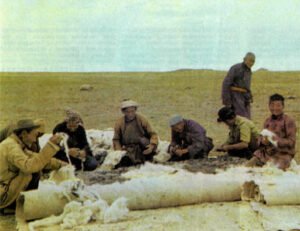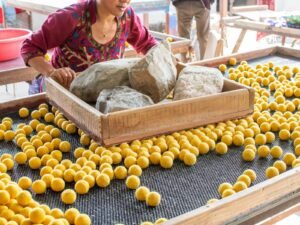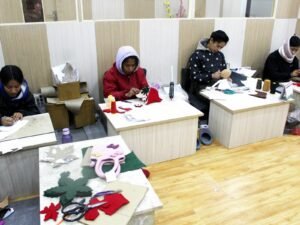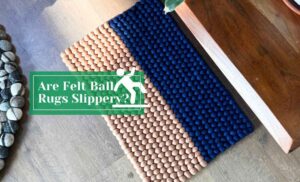Felt is a versatile and long-lasting material that humans have used for thousands of years. Felt has played an important role in many cultures around the world, from nomadic tribes of Central Asia to contemporary artists. In this article, we’ll look at the history and culture of felt, as well as how it evolved from a survival material to a medium for artistic expression.
The History of Felt
Felt’s exact origins are unknown, but it is thought to have been invented by nomadic tribes of Central Asia, who used it to make tents, clothing, and other necessities. Felt is created by matting together wool fibers with heat, moisture, and pressure, resulting in a dense and strong material that can be shaped and molded into a variety of shapes. Because it was lightweight, easy to transport, and provided insulation against the harsh elements of the Central Asian steppes, felt was an ideal material for nomadic people.
Felt in Central Asian Culture
For thousands of years, felt has played an important role in Central Asian culture. The Kyrgyz people, for example, are famous for their yurts, which are portable felt tents that have been used as homes and meeting places for centuries. The Kazakhs, on the other hand, are well-known for their ornate felt carpets with intricate designs and colors. Felt has been used for decorative purposes in Central Asian culture, as well as for practical purposes, with many traditional costumes and accessories featuring felted details.
 Felt in Contemporary Art
In recent years, felt has grown in popularity among contemporary artists, who use it to create a variety of sculptures, installations, and other works of art. Felt’s soft and malleable nature allows artists to experiment with it, and its rich history and cultural significance add depth and meaning to their works.
Chiharu Shiota, a Japanese artist who creates intricate installations out of thousands of strands of red yarn, is one of the most well-known contemporary felt artists. Her works, which have been shown in galleries and museums all over the world, frequently explore themes of memory, identity, and the human experience.
Lucy Sparrow, a British artist who creates life-sized felt replicas of everyday objects such as cans of food and bottles of ketchup, is another artist who has made a name for herself working with felt. Her works are whimsical and playful, and they frequently comment on consumer culture and the disposable nature of modern society.
Felt in Contemporary Art
In recent years, felt has grown in popularity among contemporary artists, who use it to create a variety of sculptures, installations, and other works of art. Felt’s soft and malleable nature allows artists to experiment with it, and its rich history and cultural significance add depth and meaning to their works.
Chiharu Shiota, a Japanese artist who creates intricate installations out of thousands of strands of red yarn, is one of the most well-known contemporary felt artists. Her works, which have been shown in galleries and museums all over the world, frequently explore themes of memory, identity, and the human experience.
Lucy Sparrow, a British artist who creates life-sized felt replicas of everyday objects such as cans of food and bottles of ketchup, is another artist who has made a name for herself working with felt. Her works are whimsical and playful, and they frequently comment on consumer culture and the disposable nature of modern society.
 The market for felt products has grown significantly in recent years, with many artisans and crafters creating unique and high-quality pieces for sale. Online marketplaces and craft fairs provide a platform for these makers to showcase and sell their felt products, allowing them to reach a wider audience and connect with customers who appreciate the time and skill that goes into each piece. The demand for sustainable and eco-friendly materials has also contributed to the popularity of felt products, as felt is a natural and renewable material that can be produced without the use of harmful chemicals or processes.
From its origins in Central Asia to its use in contemporary art, felt has a rich and varied history. Because of its versatility and durability, it has become an important material for survival and artistic expression, and its cultural significance continues to inspire artists and craftspeople worldwide. Whether you want to make a practical item for everyday use or a work of art that pushes the medium’s boundaries, felt is a material worth exploring and celebrating.
The market for felt products has grown significantly in recent years, with many artisans and crafters creating unique and high-quality pieces for sale. Online marketplaces and craft fairs provide a platform for these makers to showcase and sell their felt products, allowing them to reach a wider audience and connect with customers who appreciate the time and skill that goes into each piece. The demand for sustainable and eco-friendly materials has also contributed to the popularity of felt products, as felt is a natural and renewable material that can be produced without the use of harmful chemicals or processes.
From its origins in Central Asia to its use in contemporary art, felt has a rich and varied history. Because of its versatility and durability, it has become an important material for survival and artistic expression, and its cultural significance continues to inspire artists and craftspeople worldwide. Whether you want to make a practical item for everyday use or a work of art that pushes the medium’s boundaries, felt is a material worth exploring and celebrating.
 If you want to see the beauty and versatility of felt for yourself, take a look at our handmade felt products. We offer a wide range of high-quality felt items that are sure to delight, from cozy slippers and warm scarves to unique ornaments and decorative wall hangings. Explore our collection today and experience the joy of handmade felt products!
If you want to see the beauty and versatility of felt for yourself, take a look at our handmade felt products. We offer a wide range of high-quality felt items that are sure to delight, from cozy slippers and warm scarves to unique ornaments and decorative wall hangings. Explore our collection today and experience the joy of handmade felt products!
 Felt in Contemporary Art
In recent years, felt has grown in popularity among contemporary artists, who use it to create a variety of sculptures, installations, and other works of art. Felt’s soft and malleable nature allows artists to experiment with it, and its rich history and cultural significance add depth and meaning to their works.
Chiharu Shiota, a Japanese artist who creates intricate installations out of thousands of strands of red yarn, is one of the most well-known contemporary felt artists. Her works, which have been shown in galleries and museums all over the world, frequently explore themes of memory, identity, and the human experience.
Lucy Sparrow, a British artist who creates life-sized felt replicas of everyday objects such as cans of food and bottles of ketchup, is another artist who has made a name for herself working with felt. Her works are whimsical and playful, and they frequently comment on consumer culture and the disposable nature of modern society.
Felt in Contemporary Art
In recent years, felt has grown in popularity among contemporary artists, who use it to create a variety of sculptures, installations, and other works of art. Felt’s soft and malleable nature allows artists to experiment with it, and its rich history and cultural significance add depth and meaning to their works.
Chiharu Shiota, a Japanese artist who creates intricate installations out of thousands of strands of red yarn, is one of the most well-known contemporary felt artists. Her works, which have been shown in galleries and museums all over the world, frequently explore themes of memory, identity, and the human experience.
Lucy Sparrow, a British artist who creates life-sized felt replicas of everyday objects such as cans of food and bottles of ketchup, is another artist who has made a name for herself working with felt. Her works are whimsical and playful, and they frequently comment on consumer culture and the disposable nature of modern society.
 The market for felt products has grown significantly in recent years, with many artisans and crafters creating unique and high-quality pieces for sale. Online marketplaces and craft fairs provide a platform for these makers to showcase and sell their felt products, allowing them to reach a wider audience and connect with customers who appreciate the time and skill that goes into each piece. The demand for sustainable and eco-friendly materials has also contributed to the popularity of felt products, as felt is a natural and renewable material that can be produced without the use of harmful chemicals or processes.
From its origins in Central Asia to its use in contemporary art, felt has a rich and varied history. Because of its versatility and durability, it has become an important material for survival and artistic expression, and its cultural significance continues to inspire artists and craftspeople worldwide. Whether you want to make a practical item for everyday use or a work of art that pushes the medium’s boundaries, felt is a material worth exploring and celebrating.
The market for felt products has grown significantly in recent years, with many artisans and crafters creating unique and high-quality pieces for sale. Online marketplaces and craft fairs provide a platform for these makers to showcase and sell their felt products, allowing them to reach a wider audience and connect with customers who appreciate the time and skill that goes into each piece. The demand for sustainable and eco-friendly materials has also contributed to the popularity of felt products, as felt is a natural and renewable material that can be produced without the use of harmful chemicals or processes.
From its origins in Central Asia to its use in contemporary art, felt has a rich and varied history. Because of its versatility and durability, it has become an important material for survival and artistic expression, and its cultural significance continues to inspire artists and craftspeople worldwide. Whether you want to make a practical item for everyday use or a work of art that pushes the medium’s boundaries, felt is a material worth exploring and celebrating.
 If you want to see the beauty and versatility of felt for yourself, take a look at our handmade felt products. We offer a wide range of high-quality felt items that are sure to delight, from cozy slippers and warm scarves to unique ornaments and decorative wall hangings. Explore our collection today and experience the joy of handmade felt products!
If you want to see the beauty and versatility of felt for yourself, take a look at our handmade felt products. We offer a wide range of high-quality felt items that are sure to delight, from cozy slippers and warm scarves to unique ornaments and decorative wall hangings. Explore our collection today and experience the joy of handmade felt products!




